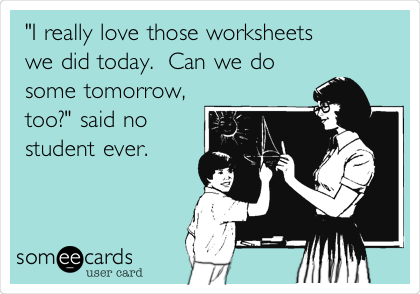
As we plan learning experiences for our students along the learning continuum, how can we make them more engaging, contextualized, and communicative?
Let’s begin with some definitions for the purpose of our conversation:
Exercises:
https://www.someecards.com/usercards/viewcard/MjAxMi01MjYxNDg2Yjc3ZDIwZmQ0/
Exercises are often recall-based, highly structured, somewhat controlled and guided. Students complete exercises individually, typically in the form of a worksheet. Exercises may be used during the guided phase of instruction. Exercises may not be cognitively challenging for advanced learners and may not be engaging to reluctant learners.
Activities:
Classroom activities are typically structured around a routine, process, or strategy. Some examples are information gap activities, think-pair-share, and inside-outside circles. They are often hands-on and interactive and are planned for the guided or independent phases of the lesson. Here are some links below for additional ideas for strategies for classroom activities:
Tasks:
Classroom tasks involve a context, based on a problem, challenge or scenario. The students have a purpose for completing the task, the steps of the task should be outlined, and expectations for the performance or product students create are clear. Tasks are completed individually by students or in small groups.
How can I make exercises, activities and tasks more engaging and purposeful?

- Provide an authentic context: create a scenario which provides a context, possibly based on an authentic resource. Consider a real life context for the exercise or activity. For example, in lieu of using a Powerpoint with visuals to introduce new vocabulary, use an infographic or tweets in the target language.
- Make activities communicative, interactive, and engaging: transform individual exercises to activities where students work collaboratively, are hands-on, use technology, and allow students to be creative. Ensure that the activity gives students a reason to communicate and builds their confidence for using the target language independently, while providing supports to allow them to persevere through the activity in the target language.
- Design tasks that connect to real life: consider how students can solve a problem or challenge with the content and structures they have gained and thus see the connection between their learning and the real world such as pop culture, current events, and world problems. Brainstorm scenarios using the SCRAP acronym, including a situation, challenge, role, audience, and product. Tasks should be scaffolded and supported for struggling learners and should be more open-ended to provide challenge to advanced learners.
An example for moving from exercises to activities to tasks:
Here’s an example of an exercise (worksheet) for the comparative and superlative in Spanish:
Move an exercise to an activity by adding context using posts from Twitter in the target language containing the comparative and superlative:
Create a real life task where students use an infographic to give advice to travelers about best seats to select on planes using comparatives and superlatives:
Visit the webpage linked below to access ideas for designing real world tasks:





